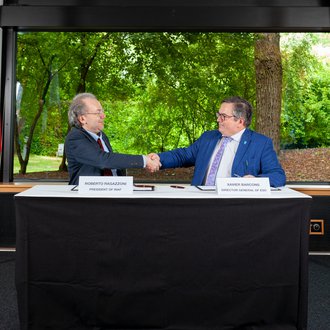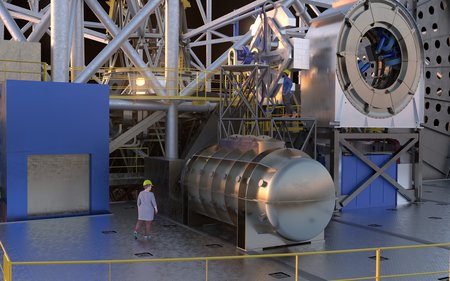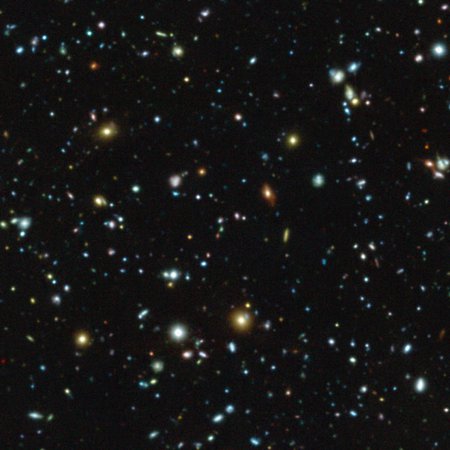ESO signs agreement for ANDES instrument on the ELT

Roberto Ragazzoni, the President of Italy’s National Institute for Astrophysics (INAF), and Xavier Barcons, ESO’s Director General, signed an agreement for the design and construction of the ANDES instrument.
Credit: ESOThe European Southern Observatory (ESO) has signed an agreement with an international consortium of institutions for the design and construction of ANDES, the ArmazoNes high Dispersion Echelle Spectrograph. The ANDES instrument will be installed on ESO’s Extremely Large Telescope (ELT). It will search for signs of life on exoplanets, identify the first stars, test variations in fundamental constants of physics, and measure the acceleration of the Universe’s expansion. The Leibniz Institute for Astrophysics Potsdam (AIP) is involved in the development of ANDES and is contributing its expertise and know-how to this international project.
The agreement was signed by ESO’s Director General Xavier Barcons and Roberto Ragazzoni, President of Italy’s National Institute for Astrophysics (INAF), which leads the ANDES consortium. The signing ceremony at ESO Headquarters in Garching, Germany, was attended by dignitaries from ESO, INAF, and other consortium members, including Vincenzo Fiorentini, Science Counselor at the Italian Embassy in Berlin, and Alessandro Marconi, ANDES Principal Investigator.
"We are very excited about today," says Prof. Dr Klaus Strassmeier from AIP, former ANDES Executive Board member for Germany, "The instrument will help to analyse the atmospheres of Earth-like exoplanets to search for signs of life. It will also use its data to check whether the fundamental physical constants change over time and space, and will directly measure the expansion and acceleration of the universe."
Formerly known as HIRES, ANDES is a powerful spectrograph, an instrument which splits light into its component wavelengths so astronomers can determine important properties about astronomical objects, such as their chemical compositions. The instrument will have a record-high wavelength precision in the visible and near-infrared regions of light and, when working in combination with the powerful mirror system of the ELT, it will pave the way for research spanning multiple areas of astronomy. The AIP is responsible for developing and building the optical-ultraviolet arm of the ANDES spectrograph, called ANDES-UBV.
“ANDES is an instrument with an enormous potential for groundbreaking scientific discoveries, which can deeply affect our perception of the Universe far beyond the small community of scientists,” says Marconi. Céline Péroux, the project scientist of the ESO team following up on ANDES, adds that the science cases range “from potentially detecting signatures of life in other worlds and identifying the very first generation of stars, to studying the variations in the fundamental constants of physics.” Prof. Dr Katja Poppenhäger from AIP, current ANDES Executive Board member for Germany, explains: “The search for biosignatures on planets outside the solar system needs the vast light-collecting power of the Extremely Large Telescope.”
ANDES will conduct detailed surveys of the atmospheres of Earth-like exoplanets and enable astronomers to search for signs of life forms. It will analyse chemical elements in distant objects from the early universe and will probably be the first instrument to detect Population III stars, the earliest stars in the universe. In addition, scientists will be able to use ANDES data to test whether fundamental physical constants change with time and space. Its comprehensive data will also measure the acceleration of the Universe’s expansion, one of the most pressing mysteries about the cosmos.
ESO’s ELT, currently under construction in the Atacama Desert of Northern Chile, will feature a primary mirror 39 meters in diameter, composed of 798 hexagonal segments. Set to begin operations later this decade, the ELT will become the world’s largest optical telescope, ushering in a new era of ground-based astronomy. The ANDES project is developed by an international consortium composed of research institutes in 13 countries. They are:
Brazil: Board of Stellar Observational Astronomy, Universidade Federal do Rio Grande do Norte, Observatório Nacional.
Canada: Observatoire du Mont-Mégantic and the Trottier Institute for Research on Exoplanets, Université de Montréal.
Denmark: Instrument Centre for Danish Astrophysics on behalf of Niels Bohr Institute, Aarhus University, Danmarks Tekniske Universitet.
France: Centre National de la Recherche Scientifique (CNRS) on behalf of Observatoire de la Côte d’Azur, Université Côte d’Azur (LAGRANGE), Laboratoire d’Astrophysique de Marseille, Aix-Marseille Université, Centre National d’Etudes Spatiales (LAM), Institut de Recherche en Astrophysique et Planetologie, Université Toulouse III-Paul Sabatier (IRAP), Institut de Planétologie et d’Astrophysique de Grenoble, Université Grenoble-Alpes (IPAG), Laboratoire Univers et Particules de Montpellier, Université de Montpellier (LUPM), Institut d’Astrophysique de Paris, Sorbonne Université (IAP), Laboratoire de Météorologie Dynamique, Ecole Normale Supérieure, Ecole Polytechnique, Sorbonne Université (LMD).
Germany: Leibniz-Institut für Astrophysik Potsdam (AIP), Institut für Astrophysik und Geophysik, Georg-August-Universität Göttingen (IAG), Atmospheric Physics of Exoplanets Department, Max-Planck-Institut für Astronomie Heidelberg (MPIA), Zentrum für Astronomie, Universität Heidelberg (ZAH), Thüringer Landessternwarte Tautenburg (TLS), Hamburger Sternwarte, Universität Hamburg (UHH).
Italy: INAF, Istituto Nazionale di Astrofisica (Lead Technical Institute).
Poland: Nicolaus Copernicus University in Torun.
Portugal: Instituto de Astrofísica e Ciências do Espaço (IA) at Centro de Investigaço em Astronomia/Astrofísica da Universidade do Porto (CAUP), Instituto de Astrofísica e Ciências do Espaço at Faculdade de Ciências da Universidade de Lisboa, Associação para a Investigação e Desenvolvimento de Ciências (FCiências.ID)
Spain: Instituto de Astrofísica de Canarias (IAC); Consejo Superior de Investigaciones Científicas (CSIC, Spain) on behalf of Instituto de Astrofísica de Andalucía (IAA), Centro de Astrobiología de Madrid (CSIC-INTA).
Sweden: Lund University, Stockholm University, Uppsala University.
Switzerland: Département d’Astronomie, Université de Genève; Weltraumforschung und Planetologie, Physikalisches Institut, Universität Bern.
United Kingdom: Science and Technology Facilities Council, United Kingdom Research and Innovation on behalf of Cavendish Laboratory & Institute of Astronomy, University of Cambridge; UK Astronomy Technology Centre; Institute of Photonics and Quantum Sciences, Heriot-Watt University.
USA: Department of Astronomy, University of Michigan.
Images
Roberto Ragazzoni, the President of Italy’s National Institute for Astrophysics (INAF), and Xavier Barcons, ESO’s Director General, signed an agreement for the design and construction of the ANDES instrument.
Big screen size [1000 x 666, 140 KB]
Original size [4341 x 2894, 2.0 MB]
The high-resolution spectrograph ANDES in this artist's impression is going to be one of the instruments at the Extremely Large Telescope (ELT) in Chile.
Big screen size [1000 x 625, 130 KB]
Original size [4000 x 2500, 1.5 MB]




